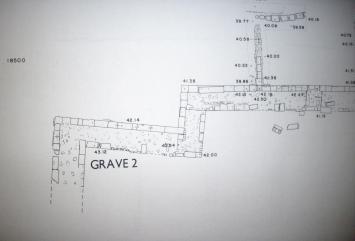Examples in Archaeology: The Multiple Burial in the Corner of the Hexamilion North of the Roman Bath (Gully Bastion)
When and where the feature was found
The multiple burial (Grave 2 Gully Bastion) is located in the Corner of the Hexamilion North of the Roman Bath at Isthmia. The grave cut into what is assumed to be ground level at the time of the construction of the Hexamilion wall which is a hard white soil. The grave itself was excavated in the 1970 season and was found under a later kiln or oven.

Gregory, T.E., Isthmia: Vol.5, The Hexamilion and the Fortress (1993)
Topelev = 41.08
Botelev = 40.18
Brief Description
Located in a corner of the Hexamilion wall the Gully Bastion Grave Two has the interior face of the wall forming both the West and the North sides with the North side slightly undercutting the Hexamilion by around 20cm. The sides of the grave are lined with large tiles, these tiles also included in their number one stamped tile[1] and another which being heavily smoke stained indicates that it may have originally been part of the nearby Roman Bath.[2] The interpretation of this tile as formerly of the Roman Bath is also suggested by how the smoke staining does not extend to the corners of the tile where it would have been resting on top of hypocausts.
The grave is actually split into two irregular sections, North and South. These two sections were split by a line of vertical tiles which ran West to East across the grave. Within the north section was found two skeletons with their heads to the west and within the south compartment eight skeletons were uncovered also with their heads to the west. There is some debate to who these individuals were, whether they were part of the garrison assigned to guard or build the Hexamilion or from some other associated part of society.
Underneath the lowest body in the southern section a number of artefacts were found, namely an Athenian glazed lamp fragment which shares much of the characteristics of other lamps found in the Roman Bath (IPL 70-100)[3] which can be dated to the second half of the fourth century after Christ. There is debate over the function of the lamp in the grave. Was it part of some religious ceremony for the deceased or simply just lost or for another reason yet to be thought of? Either way this lamp fragment allows for the best dating of the grave in relation to similar lamps found in the Roman Bath as mentioned previous. Several other items were found in the same area as the lamp fragment including a coarse dark reddish bowl (IPR 70-26) which like the lamp can be dated to the second half of the fourth century.[4] A bronze buckle (IM 70-32) and a bead on a wire (IM 70-54) were also excavated.
Interpretation:
The north side of the grave undercutting the Hexamilion along with the relation between the lamp fragment found in the south section of the grave in relation to lamps found in Roman Bath dating to the fourth century suggest that the grave was contemporary with the construction of the Hexamilion. This is further indicated by how the grave sides are the interior of the wall on two sides. The graves construction can hence be placed either at the time the Hexamilion was being built or slightly after but before the kiln/oven was placed on top.
The position of the skeletons within the grave suggests primarily a Christian burial with the skeleton’s heads to the west. Christian burials of the period were generally orientated East-West with the head to the West end of the grave in order to mirror the layout of the Christian Church and the direction from which Christ is meant to come on judgement day.
References
Gregory, T.E., Isthmia: Vol.5, The Hexamilion and the Fortress (1993), pp.42-45
Notebooks:
Gully Bastion 1970 Vol.2 – pp.47-72 May 1970
Gully Bastion 1970 Vol.3
Wohl ‘Deposit of Lamps’ No. 24
Fraser, P.M., Archaeology in Greece, 1970-71, Archaeological reports, No.17 (1970-71), p.9
